CREATIVITY FOR PEAK PERFORMANCE
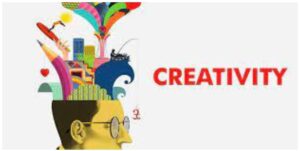
Introduction:
Peak performance is the ability to perform at one’s best, consistently achieving superior results in a chosen field. Creativity, on the other hand, is the ability to come up with novel and innovative ideas. While peak performance is often associated with excellence in a particular skill or domain, creativity is essential for achieving sustained success. This is because, to maintain a competitive edge, individuals must be able to think outside the box, adapt to changing circumstances, and find new and innovative solutions to problems. I wanted to write and give value to my readers, but my creative channels remained locked and I could find no innovative key to open them up and start writing.
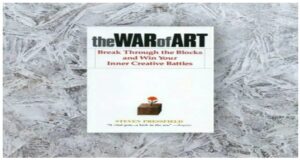
As a result, I became a terrible procrastinator when it came to writing. I had a burning desire to write and get my articles published, but every time I sat down to write, I found myself confronting a debilitating resistance that made me put off my writing or tear up whatever I had written. This went on for several years, and I felt like I was stuck in a rut. That’s when I discovered Steven Pressfield’s book, “The War of Art,” and everything changed.
I first heard about the book when I stumbled upon an interview with Steven Pressfield on the Spartan Up podcast back in 2017. His words resonated with me, and I was immediately intrigued. I decided to purchase the book and read it in a single day.
As I delved deeper into the book, I found answers as to why my creativity was getting impeded, and I learned how to overcome it. The book provided valuable insights and strategies for overcoming resistance and tapping into my creative potential. Armed with this knowledge, I was able to finally break through the resistance and start writing again.
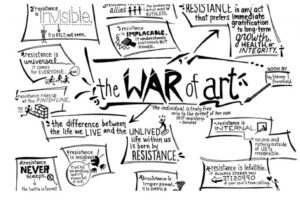
“The War of Art” was a powerful resource for me, and it helped me overcome my creative blocks and procrastination. It taught me that resistance is a natural part of the creative process and that I need to push through it to achieve my goals. The book provided me with a roadmap for unlocking my creative potential and helped me turn into a published author of four books.
Today, I am proud to say that I have published several articles, and I am well on my way to achieving my writing goals. “The War of Art” was the catalyst that helped me transform my life and tap into my full potential. I am forever grateful for the lessons I learned from this incredible book.
Books and movies can be powerful tools for exploring the role of creativity in peak performance. “Creative Confidence” and “The War of Art” provide practical insights and strategies for leveraging creativity to achieve success, while “The Social Network”. By exploring these resources, individuals can cultivate their creativity and achieve their full potential in their chosen fields.
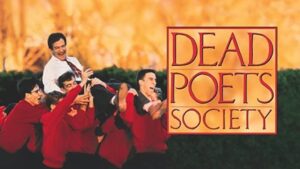
I was particularly fascinated by the movie “Dead Poets Society” “ which tells the story of an English teacher who inspires his students to think creatively and pursue their passions. It demonstrates the power of creative thinking in transforming lives and inspiring change. The movie also explores the challenges of maintaining a creative vision in the face of societal norms and expectations.
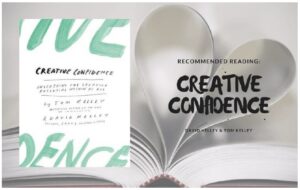
The book “Creative Confidence” by Tom Kelley and David Kelley is my top pick. This book explores the role of creativity in problem-solving and innovation. The authors, who are the founders of the design firm IDEO, share their insights and experiences in helping individuals and organizations unlock their creative potential. The book provides practical strategies for overcoming creative blocks and fostering a culture of innovation, making it a valuable resource for anyone looking to leverage their creativity for peak performance. Having overcome my creative block, I believe for peak performance it is imperative to explore the science of creativity and provide strategies for cultivating creativity to enhance performance.
Divergent Thinking:
Divergent thinking is the ability to generate multiple solutions to a problem, often by thinking outside the box. This type of thinking is crucial for creativity because it allows individuals to consider multiple perspectives and come up with unique solutions. In contrast, convergent thinking is the process of finding a single solution to a problem. While convergent thinking is necessary for some tasks, such as solving a math problem or following a recipe, divergent thinking is essential for creative problem- solving.
To cultivate divergent thinking, individuals can engage in activities that encourage exploration and experimentation. For example, brainstorming sessions can be a powerful tool for generating a wide range of ideas. During a brainstorming session, individuals are encouraged to share their ideas without fear of judgment. This allows for a free-flowing exchange of ideas, which can lead to innovative solutions. Another way to encourage divergent thinking is to engage in creative exercises, such as drawing or writing prompts, which challenge individuals to think outside the box.
Brainstorming:
Brainstorming is a powerful tool for generating creative ideas. During a brainstorming session, individuals are encouraged to share their ideas without fear of judgment. This allows for a free-flowing exchange of ideas, which can lead to innovative solutions. Brainstorming can be used for a wide range of tasks, from developing new products to solving complex problems.
To facilitate a successful brainstorming session, it is important to create a safe and supportive environment. This means that all ideas should be welcomed and respected, even if they seem unrealistic or impractical. It is also important to set clear goals and guidelines for the session so that everyone is on the same page. Finally, it is important to follow up on the ideas generated during the session, by evaluating their feasibility and developing a plan of action.
Incubation:
Incubation is the process of letting an idea or problem simmer in the mind, without actively thinking about it. This allows the subconscious mind to work on the problem in the background, leading to new insights and solutions. Incubation is an important part of the creative process because it allows individuals to take a break from actively thinking about a problem, which can lead to new perspectives and insights.
To cultivate incubation, individuals can engage in activities that promote relaxation and downtime, such as meditation or taking a walk in nature. It is also important to permit oneself to take a break from actively thinking about a problem, and to trust that the subconscious mind will continue to work on it in the background.
Examples:
The role of creativity in peak performance can be seen in a wide range of fields, from business to the arts. For example, Steve Jobs, the co-founder of Apple, was known for his creativity and innovative thinking. He was able to transform the technology industry by introducing new products, such as the iPhone and iPad, that revolutionized the way people interact with technology.
Similarly, J.K. Rowling, the author of the Harry Potter series, used her creativity to create a rich and complex world that has captured the imaginations of millions of readers worldwide. Her ability to think outside the box and create a unique and engaging story has made her one of the most successful authors of all time.
In the world of sports, creativity is also essential for peak performance. For example, Brazilian soccer player Pelé was known for his creative and innovative style of play, which allowed him to dominate the field and score goals in new and unexpected ways. Similarly, basketball player Michael Jordan was able to use his creativity and innovative thinking to develop new strategies and techniques that helped him become one of the most successful players in NBA history.
LEVERAGING CREATIVITY IN THE MODERN TECHNOLOGICAL ERA
In the modern technological era, there are various ways that we can leverage creativity for peak performance. Here are some strategies:
Use Technology for Inspiration: Technology has made it easier than ever to find inspiration and generate new ideas. Social media platforms, search engines, and online communities can provide access to a wealth of information and perspectives. By using these resources, individuals can stay up-to-date on the latest trends and developments, and draw inspiration from diverse sources.
Collaborate Virtually: Technology has also made it possible to collaborate with individuals from around the world, regardless of location. This can provide access to diverse perspectives and skill sets, leading to more innovative and effective solutions. Virtual collaboration tools such as video conferencing, shared workspaces, and project management software can help facilitate this process.
Use Creative Software: There are various creative software tools available that can help individuals bring their ideas to life. For example, graphic design software, video editing software, and animation software can all be used to create visually engaging content. These tools can be especially useful for individuals in fields such as marketing, advertising, and content creation.
Embrace Emerging Technologies: Emerging technologies such as artificial intelligence, virtual reality, and blockchain are changing the way we work and create. By embracing these technologies and exploring their potential applications, individuals can stay at the forefront of innovation and find new ways to leverage creativity for peak performance.
Make Time for Creative Activities: With the constant demands of work and technology, it can be easy to neglect creative pursuits. However, making time for activities such as writing, painting, or music can help individuals maintain their creative spark and develop new skills that can be applied in their work. By prioritizing creative activities, individuals can foster a more innovative and creative mindset, leading to enhanced performance.
CAN CREATIVITY BE BIO-HACKED FOR PEAK PERFORMANCE?
While creativity is often associated with innate talent or inspiration, there are certainly ways to enhance creative abilities through biohacking. Here are some methods that may help bio-hack creativity for peak performance:

Optimize sleep: Getting adequate sleep is crucial for creative thinking. Sleep helps consolidate memories and clears the mind, allowing for fresh ideas to surface. To optimize sleep, consider using tools like blue-light-blocking glasses, optimizing the sleeping environment, and implementing a consistent sleep schedule.
Exercise: Regular exercise has been shown to enhance cognitive function, including creativity. Exercise increases blood flow and oxygen to the brain, which can improve focus and generate new ideas. Additionally, exercise has been shown to reduce stress and anxiety, which can be major barriers to creativity.
Nootropics: Nootropics are supplements or drugs that are believed to enhance cognitive performance. Some nootropics, such as caffeine and modafinil, have been shown to improve creativity by increasing alertness and reducing fatigue. However, it’s important to do research and consult a healthcare professional before experimenting with nootropics.
Mindfulness: Mindfulness meditation has been shown to improve divergent thinking, which is a key component of creative thinking. Mindfulness can help reduce distractions and increase focus, allowing for more innovative ideas to emerge.
Brainstorming techniques: Several brainstorming techniques can help facilitate creativity, such as mind mapping, reverse brainstorming, and random word association. These techniques can help break down mental barriers and encourage novel thinking.
Creativity exercises: There are a variety of creativity exercises that can be used to train the brain to think more creatively. For example, the “six thinking hats” exercise involves wearing different “hats” to approach a problem from different perspectives. Another exercise is “random word stimulation,” where a random word is chosen and used as a starting point for generating new ideas.
Overall, creativity can be biohacked for peak performance. However, it’s important to remember that creativity is a complex and multifaceted process, and what works for one person may not work for another.
Conclusion:
In conclusion, creativity is an essential component of peak performance. It allows individuals to approach problems in new and innovative ways, leading to superior results and sustained success. By cultivating divergent thinking, engaging in brainstorming sessions, and promoting incubation, individuals can enhance their creativity and achieve peak performance in their chosen field. The examples of Steve Jobs, J.K. Rowling, Pelé, and Michael Jordan demonstrate how creativity can lead to exceptional success, both in business and in sports. By harnessing the power of creativity, individuals can achieve their full potential and make a lasting impact in their field.
 Dr K. Jayanth Murali is a retired IPS officer and a Life Coach. He is the author of four books, including the best-selling 42 Mondays. He is passionate about painting, farming, and long-distance running. He has run several marathons and has two entries in the Asian book of Records in full and half marathon categories. He lives with his family in Chennai, India. When he is not running, he is either writing or chilling with a book.
Dr K. Jayanth Murali is a retired IPS officer and a Life Coach. He is the author of four books, including the best-selling 42 Mondays. He is passionate about painting, farming, and long-distance running. He has run several marathons and has two entries in the Asian book of Records in full and half marathon categories. He lives with his family in Chennai, India. When he is not running, he is either writing or chilling with a book.
